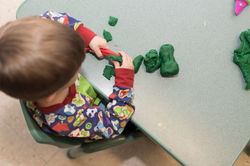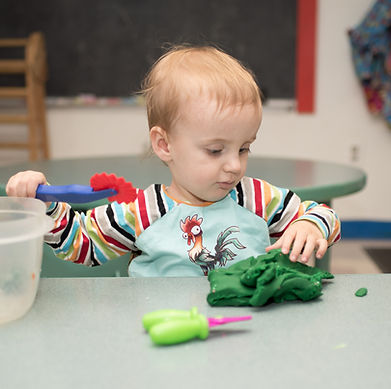 |  |  |
|---|
Arts & Crafts
Children love spending time lost in a world art and craft materials, and we know that they're building skills, too! They're developing the fine motor skills that they will need for so many things as they grow. They're also engaging their imaginations, exploring new ideas, and beginning to develop a sense of style.
Scroll down for information about supporting your young artist's development, our signature play-dough recipe, and our monthly craft activities.
How to Support Your Child's Artistic Development
Art in early childhood means fun and exploration!
We strongly encourage parents and caregivers of young children to create artistic experiences that are child-centered and child-led.
We think it's all about process art for young kids, and we encourage you to make art time all about exploration and discovery.
What is process art?

First and foremost, process art is child-directed. From the available materials, the child chooses which to use and how to use them.
Process art is open-ended. It does not start with a specific outcome in mind. Sometimes, children may begin with an idea for a finished product; joyful exploration happens whether they do or don't, as long as the idea comes from the child's imagination.
The child is not following step-by-step directions or being taught "correct" technique. Instead, they are allowed to think creatively and independently. They are free to explore and discover. Of course adults will need to supervise young children and ensure that materials are being used safely, but this approach will allow children the freedom to discover the possibilities and limitations of different materials.
The toy library's art room is designed in a way that encourages process art, and grown-ups will probably find it simple and easy to facilitate at home, too. (Chances are good that you're already doing this at least some of the time!)
-
We provide a variety of different materials: paints, markers, crayons, tape, glue, stamps, sensory materials such as our homemade play-dough, and lots more!
-
We stock supplies that children can use independently, and we store them on low shelves to allow the children to serve themselves.
-
Our art room allows children to enter as they please (with adult permission and supervision) and then return to other types of play when they decide they're done.
In addition, grown-ups can be sure to make art playful and full of delight by engaging with their children throughout the process, or even joining in and exploring right alongside their children.
Ask your child open-ended questions about their work (e.g., "That's so interesting how you made the sky orange! What made you think of doing that?") and make objective observations ("You made the circles so big up here but so tiny down there!").
What about specific craft projects?
You'll actually find some on this page! Our art coordinator puts together an art or craft project each month. The focus on process art above may create the impression that we aren't fans of them, but they can be a lot of fun if they are occasional and done in a low-stress way.
We hope that kids will have plenty of time for open-ended exploration of art materials, and that projects will not be the entirety of their art time.
Projects can also offer a great opportunity to let kids explore new, interesting materials that they might not have encountered before. We suggest allowing time for this exploration before, during, and after the project. We also suggest not focusing on how to make the product look "right," as this may just result in frustration for you and your child. Consider not even showing your child what the finished product "should" look like; tell them about it, help them through the steps, and allow them creativity in the process. Celebrate the finished product as a success without worrying about how it compares to the standard.
Finally, follow your child's lead even with projects. If your child is uninterested, would rather use the materials in a different way, becomes frustrated, or is simply ready to be done before the project is complete -- it's all right! There's no reason to force your child through a "fun" activity if neither of you will actually enjoy it!

Our Homemade Play-Dough
We make our own play-dough and keep it stocked in our art room. Here's the recipe if you'd like to make some at home.
If you've got allergy concerns, you can use any kind of gluten-free/alternative flour that works for your family. Experiment with different ratios if the end product isn't exactly what you had in mind.
Ingredients
-
5 cups water
-
1/2 cup vegetable or canola oil
-
4 cups flour
-
1 cup salt
-
2 tablespoons cream of tartar
-
Food coloring (optional)
Directions

-
Combine ingredients (except food coloring) in a large pot. Mix well.
-
Warm up mixture on stove over medium to medium-high heat, stirring frequently.
-
When mixture reaches a thick, doughy consistency, remove from heat.
-
Let dough cool. Knead by hand or mix with a stand mixer. Add food coloring as desired.
Monthly Arts & Crafts Activities
Our fabulous art coordinator has developed a "craft-of-the-month" program. Members can pick up a kit (during our lending hours), which will provide most of the supplies needed to complete the craft project, along with printed instructions.
Look below to check out the current and past months' crafts! View or print a PDF with instructions for making the project yourself. We encourage you to think of these instructions as a guide and let your child exercise their creativity. We recommend that caregivers and children do these activities together, to allow for adult supervision and plenty of engagement.
BUNNY NOSE
Make a bunny nose from pipe cleaners, pom poms, and a popsicle stick: instructions.

April 2021
SALT DOUGH HEARTS
Create salt dough ornaments using heart-shaped cookie cutters and a photo of your choosing: instructions.
(*This kit is available to check out for lending. Supplies must be returned using the typical process for lending toys.)

February 2021
GROWING CRYSTAL HEARTS
Make hearts from pipe cleaners, and then let crystals grow on them inside a jar, using a Borax solution. Create something pretty and have a blast with science: instructions.
February 2021
PINE CONE BIRD FEEDER
With just a few supplies, you can put together a bird feeder, hang it up outside, and watch the birds that visit: instructions.

January 2021

